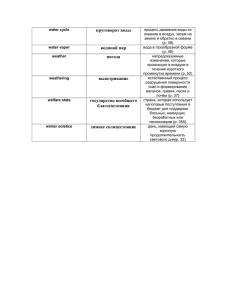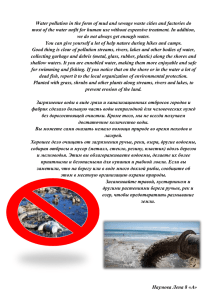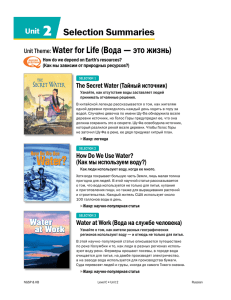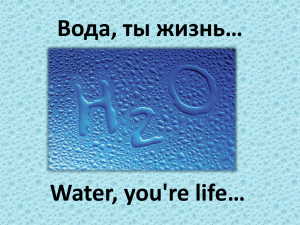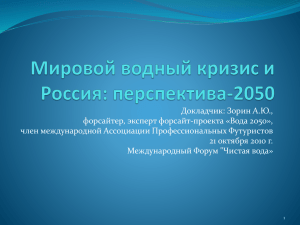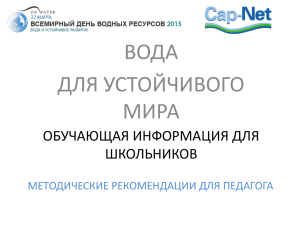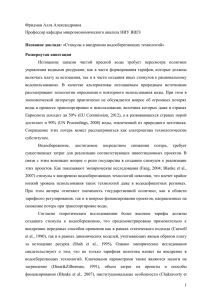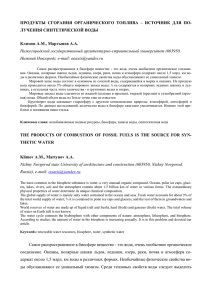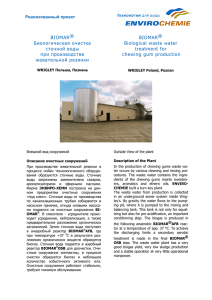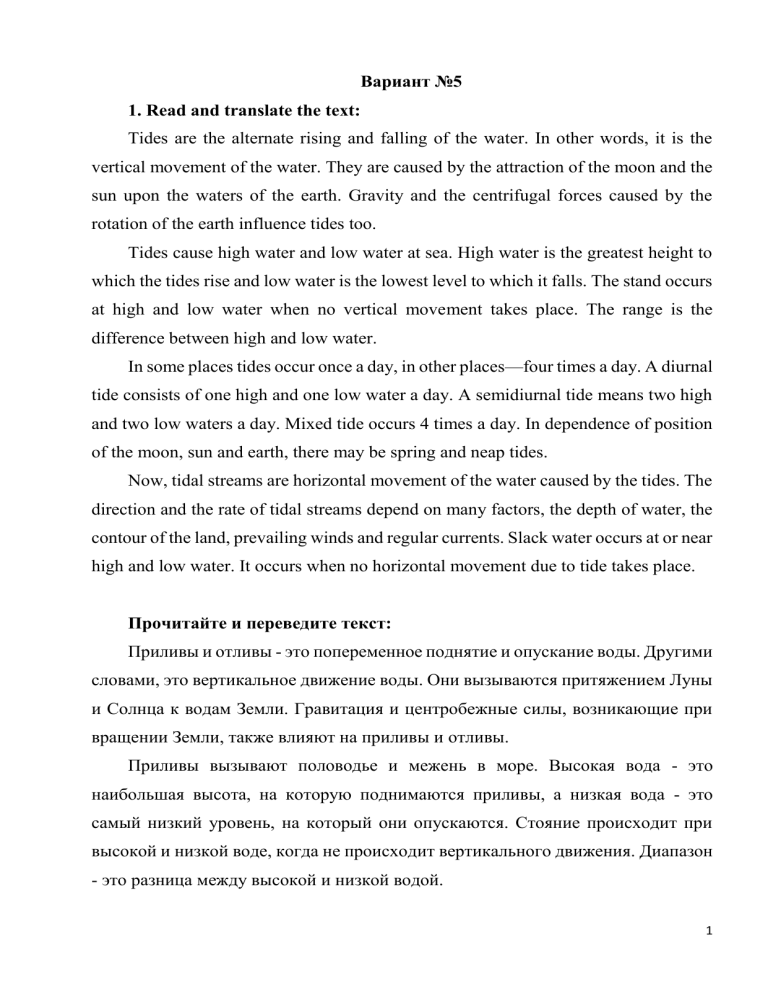
Вариант №5 1. Read and translate the text: Tides are the alternate rising and falling of the water. In other words, it is the vertical movement of the water. They are caused by the attraction of the moon and the sun upon the waters of the earth. Gravity and the centrifugal forces caused by the rotation of the earth influence tides too. Tides cause high water and low water at sea. High water is the greatest height to which the tides rise and low water is the lowest level to which it falls. The stand occurs at high and low water when no vertical movement takes place. The range is the difference between high and low water. In some places tides occur once a day, in other places—four times a day. A diurnal tide consists of one high and one low water a day. A semidiurnal tide means two high and two low waters a day. Mixed tide occurs 4 times a day. In dependence of position of the moon, sun and earth, there may be spring and neap tides. Now, tidal streams are horizontal movement of the water caused by the tides. The direction and the rate of tidal streams depend on many factors, the depth of water, the contour of the land, prevailing winds and regular currents. Slack water occurs at or near high and low water. It occurs when no horizontal movement due to tide takes place. Прочитайте и переведите текст: Приливы и отливы - это попеременное поднятие и опускание воды. Другими словами, это вертикальное движение воды. Они вызываются притяжением Луны и Солнца к водам Земли. Гравитация и центробежные силы, возникающие при вращении Земли, также влияют на приливы и отливы. Приливы вызывают половодье и межень в море. Высокая вода - это наибольшая высота, на которую поднимаются приливы, а низкая вода - это самый низкий уровень, на который они опускаются. Стояние происходит при высокой и низкой воде, когда не происходит вертикального движения. Диапазон - это разница между высокой и низкой водой. 1 В одних местах приливы происходят раз в сутки, в других - четыре раза в сутки. Суточный прилив состоит из одного прилива и одного отлива в день. Полусуточный прилив - это два прилива и два отлива в день. Смешанный прилив происходит 4 раза в сутки. В зависимости от положения Луны, Солнца и Земли могут быть весенние и нисходящие приливы. Итак, приливные потоки - это горизонтальное движение воды, вызванное приливами и отливами. Направление и скорость приливных потоков зависят от многих факторов: глубины воды, очертаний суши, преобладающих ветров и регулярных течений. Слабая вода возникает при высокой и низкой воде или вблизи них. Это происходит, когда горизонтальное движение под действием прилива отсутствует. 2. Answer the questions: 1. What are tides? ● Tides are the alternate rising and falling of the water. In other words, it is the vertical movement of the water. 2. By what are they caused? ● Tides are caused by the attraction of the Moon and Sun to the Earth's waters. 3. What is high water? ● High water is the greatest height to which the tides rise. 4. What is low water? ● low water is the lowest level to which it falls. 5. What is the range? ● The range is the difference between high and low water. 6. Of how many changes does a diurnal tide consist? ● A diurnal tide consists of one high and one low water a day. 7. Of how many changes does a semidiurnal tide consist? ● A semidiurnal tide means two high and two low waters a day. 8. What is the tidal stream? ● Tidal streams are horizontal movement of the water caused by the tides. 3. Read and translate an extract from the Sailing Directions: 2 Tidal streams 3.143 Tidal stream information for the vicinity of West Scar Light-buoy and the middle of the entrance to Swansea Bay can be obtained from the charts. Tidal streams between Oxwitch Point and Mumbles Head run in approximately the direction of the coast attaining a spring rate of 3 kn off the salient points. The E-going stream sets directly over Mixon Shoal a branch then turns N round Mumbles Head at +0610 HW Milford Haven and runs for 3 hours only towards Swansea at a spring rate of 1 kn. The main body of the stream continues E across Swansea Bay towards Port. Talbot where it divides again at – 0315 HW Milford Haven, one branch running SSE along the coast, and the other branch running anti- clockwise round the bay for 9,5 hours and attaining a spring rate of 3 to 4 kn off Mumbles Head. Прочитайте и переведите отрывок из "Наставления по парусному спорту": Приливные течения 3.143 Информация о приливных течениях в районе маяка Вест Скар и середины входа в залив Суонси может быть получена из карт. Приливные течения между мысом Оксвитч и Мамблс идут примерно в направлении берега, достигая у основных точек сизигийной скорости в 3 узла. Поток, идущий в восточном направлении, устанавливается прямо над отмелью Миксон, а затем один поток поворачивает на север вокруг мыса Мамблс +06:10 часов в северо-западном направлении в сторону гавани Милфорд и в течение 3 часов движется только в направлении Суонси с сизигийной скоростью 1 узел. Основная часть течения продолжается на восток через залив Суонси в направлении Порта. Тальбот, где основное течение опять разделяется за 3 часа 15 минут до полной воды в гавани Милфорд, одна часть течения идёт на юго-юговосток вдоль 3 побережья, а другая часть течёт вокруг бухты против часовой стрелки в течение 9,5 часов и достигает сизигийной скорости в 3-4 узла от мыса Мамблс. 4. Translate into Russian: 1. tidal stream information; ● информация о приливных течениях; 2. information can be obtained from the charts; ● информация может быть получена из карт; 3. tidal streams run in the direction of the coast; ● Приливные потоки идут в направлении побережья; 4. approximately; ● приблизительно; 5. to attain; ● достичь; 6. a spring rate of 3 kn; ● скорость пружины 3 узла; 7. off salient points; ● отделить существенные моменты; 8. to set; ● закреплять;установить; 9. to turn; ● повернуть;поворачивать; 10. the main body of the stream; ● основная часть потока ● 11. to divide; ● разделять 12. to run along the coast; ● бежать вдоль побережья 13. to run anti-clockwise; ● для запуска против часовой стрелки 14. to round the bay; 4 ● чтобы обогнуть залив; 5. Answer the questions: 1. What information can be obtained from the charts? ● Tidal stream information for the vicinity of West Scar Light-buoy and the middle of the entrance to Swansea Bay can be obtained from the charts. 2. In what direction do the tidal streams run? ● tidal currents run roughly along the shoreline 3. What spring rate do the tidal streams attain? ● The E-going stream sets directly over Mixon Shoal. 4. What stream does directly set over Mixon Shoal? ● The E-going stream sets directly over Mixon Shoal 5. What time does a branch turn N round Mumbles Head? ● A branch turns N round Mumbles Head at +0610 HW Milford Haven. 6. A branch of the E-going stream runs for 3 hours, doesn’t? ● Yes, it does. A branch of the E-going stream runs for 3 hours. 7. What is the speed of the E-going stream at a spring? ● 1 kn 8. Where does one branch of the E-going stream run? ● The main body of the stream continues E across Swansea Bay 9. What does the other branch of the E-going stream round? ● One branch running SSE along the coast, and the other branch running anticlockwise round the bay 6. Translate into English: 1.Информацию о приливо-отливном течении можно получить на морских картах. ● Tidal stream information can be obtained from the charts. 2.Приливо-отливные течения текут приблизительно в направлении побережья. 5 ● Tidal streams run in approximately the direction of the coast. 3.Восточное течение течет над отмелью Миксон. ● The eastward current flows over Mixon Shoal.?? 4.Одно течение течет вокруг мыса. ● One current flows around the cape?? 5.Основное течение опять разделяется за 3 часа 15 минут до полной воды в пункте М . 1.99 ● The main stream divides again at – 0315 HW point M. 7. Learn the abbreviations dealing with tides: Выучить сокращения, относящиеся к приливам и отливам: Tides — Приливы - HAT — Highest Astronomical Tide —наивысший теоретический уровень, возможный по астрономическим условиям; - HW — High Water — полная вода; - LAT — Lowest Astronomical Tide — наинизший теоретический уровень, возможный по астрономическим условиям; - LW — Low Water —- малая вода; - MHHW — Mean Higher High Water — средняя высокая полная вода; - MHLW — Mean Higher Low Water — средняя высокая малая вода; - MHW — Mean High Water — средняя полная вода; - MHWN — Mean High Water Neaps — средняя полная вода в квадратуру; - MHWS — Mean High Water Springs — средняя полная вода в сизигию; - MLHW — Mean Lower High Water — средняя низкая полная вода; - MLLW — Mean Lower Low Water — средняя низкая малая вода; - MLW — Mean Low Water — средняя малая вода; - MLWN — Mean Low Water Neaps — средняя малая вода в квадратуру; - MLWS — Mean Low Water Springs — средняя малая вода в сизигию; - MSL — Mean Sea Level — уровень моря; 6 8. Decipher and translate into Russian the abbreviations dealing with tides: 1. HAT – Highest Astronomical Tide – наивысший теоретический уровень, возможный по астрономическим условиям 2. HW – High Water – полная вода 3. LAT – Lowest Astronomical Tide – наинизший теоретический уровень, возможный по астрономическим условиям 4. LW – Low Water – малая вода 5. MHHW – Mean Higher High Water – средняя высокая полная вода 6. MHLW – Mean Higher Low Water – средняя высокая малая вода 7. MHW – Mean High Water – средняя полная вода 8. MHWN – Mean High Water Neaps – средняя полная вода в квадратуру 9. MHWS – Mean High Water Springs – средняя полная вода в сизигию 10.MLHW – Mean Lower High Water – средняя низкая полная вода 11.MLLW – Mean Lower Low Water – средняя низкая малая вода 12.MLW – Mean Low Water – средняя малая вода 13.MLWN – Mean Low Water Neaps – средняя малая вода в квадратуру 14.MLWS – Mean Low Water Springs – средняя малая вода в сизигию 15.MSL – Mean Sea Level – уровень моря Источники: 1. Китаевич Б.Е. Английский для моряков. 2.Пилацкий Е.С. Английский язык для судоводителей, 1999 г. 3.Таблицы приливов и отливов. 4.Дорошевич Н.О. Английский язык для судоводителей, 1962 г. 5.Стандартные фразы ИМО для общения на море. 7
